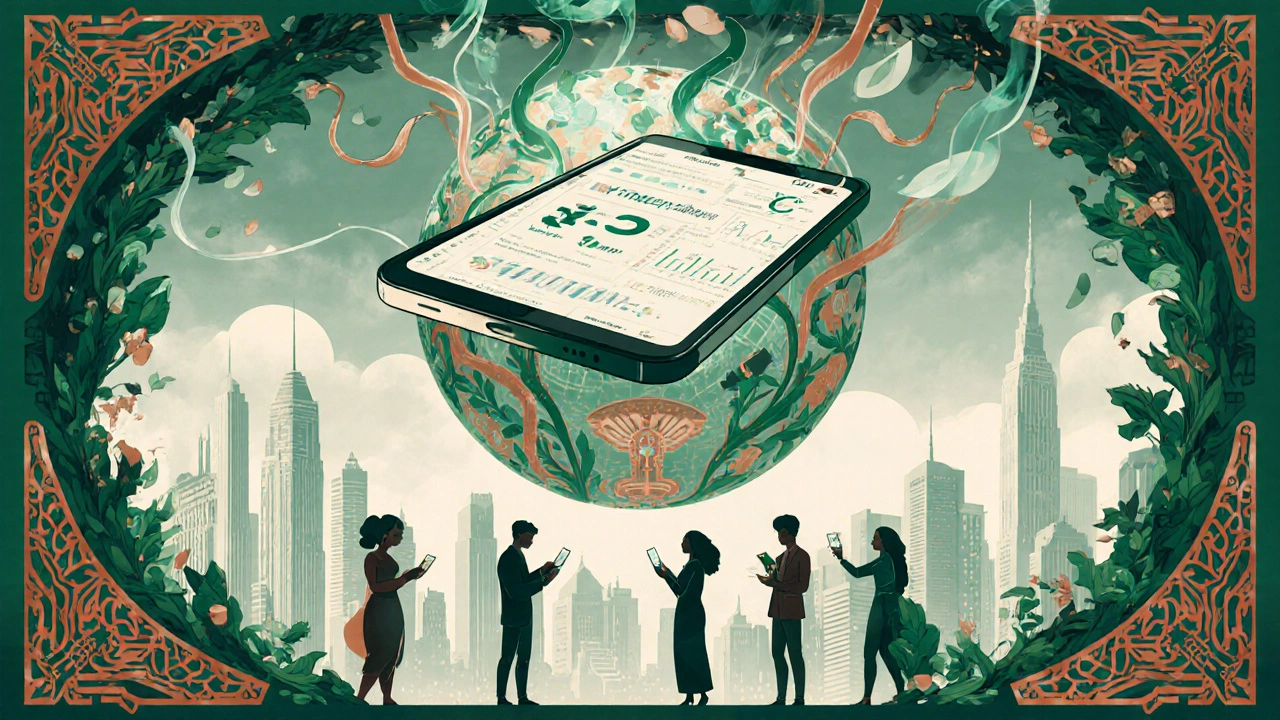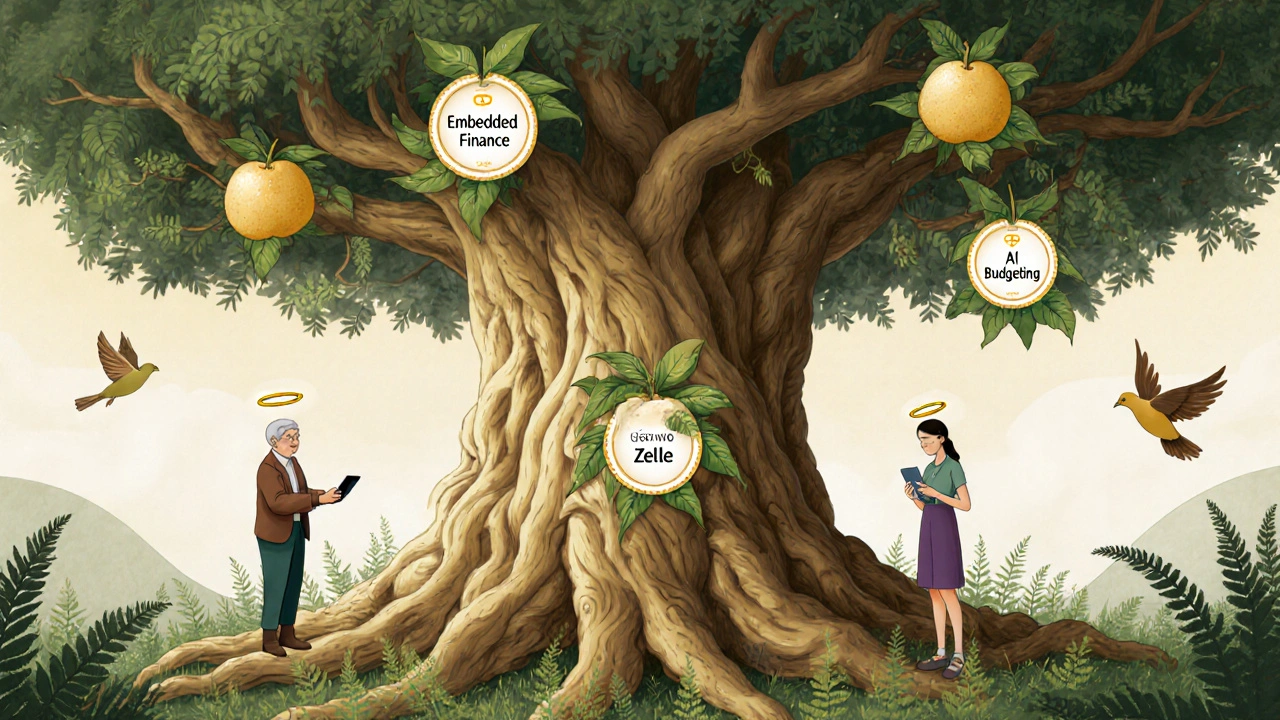Fintech Cost Comparison Calculator
Compare Banking Costs
Calculate how much you save with fintech services versus traditional banks
Fintech isn't just another buzzword. It’s the invisible force reshaping how you pay for coffee, send money to a friend, get a loan, or invest your savings. If you’ve ever used Venmo, applied for a personal loan online, or paid with your phone at the grocery store, you’ve already interacted with fintech. It’s not some distant future idea-it’s here, it’s growing, and it’s changing finance faster than most people realize.
What Exactly Is Fintech?
Fintech stands for financial technology. At its core, it’s about using technology to make financial services better, faster, and more accessible. But it’s not just any tech. To count as true fintech, it has to be something new and disruptive-not just an upgraded version of old tools.
Think about ATMs. They were revolutionary in the 1970s. Today? They’re just part of the landscape. Same with credit cards. They were once cutting-edge. Now, they’re basic. Fintech is what comes after those tools. It’s the app that gives you a loan in 10 minutes based on your phone usage patterns. It’s the platform that lets you invest $5 in stocks without a broker. It’s the system that detects fraud before you even notice a charge.
Companies like PayPal, Square, Chime, and Robinhood aren’t banks. But they’re doing things banks used to do-better, cheaper, and with less paperwork. That’s fintech: innovation that replaces, supplements, or enhances traditional finance.
The Three Eras of Fintech
Fintech didn’t start with smartphones. Its roots go back over 150 years. Historians break its evolution into three clear eras.
Fintech 1.0 (1886-1967): Building the Foundation
This was the era of infrastructure. No apps, no internet-just wires and machines. The first transatlantic cable in 1866 let banks communicate across oceans. In 1918, the U.S. launched Fedwire, the first electronic fund transfer system, using telegraph lines. Credit cards arrived in the 1950s. Diner’s Club launched the first in 1950. American Express followed in 1958. These weren’t apps. They were physical cards and manual systems. But they laid the groundwork for everything that came after.
Fintech 2.0 (1967-2008): Going Digital
The real shift happened when finance stopped being analog. In 1967, Barclays installed the world’s first ATM. Suddenly, you didn’t need a teller to get cash. In the 1970s, SWIFT made international payments faster and more secure. NASDAQ became the first digital stock exchange in 1971. Then came the internet boom.
E-Trade launched online trading in 1992. PayPal was founded in 1998 and proved people would trust digital money transfers. WebBank, created in 1997, started offering banking infrastructure to startups in 2005-letting companies like LendingClub and SoFi offer loans without needing a banking license. This era turned finance from branch-based to screen-based.
Fintech 3.0 (2008-Present): The Startup Revolution
The 2008 financial crisis changed everything. People lost trust in banks. They saw how slow, expensive, and opaque the system was. That’s when startups took over. Square launched its mobile card reader in 2009, letting any small business accept credit cards with just a phone. Google Wallet followed in 2011. Apple Pay came in 2014. Suddenly, paying with your phone wasn’t science fiction-it was normal.
Apps like Venmo, Cash App, and Zelle made splitting rent or sending birthday money as easy as texting. Robinhood made stock trading free. LendingClub and Upstart used AI to approve loans in minutes instead of weeks. Fintech 3.0 isn’t about banks using tech-it’s about tech companies doing banking better.
How Fintech Works: The Tech Behind the Scenes
Behind every fintech app is a stack of powerful technologies working together.
- Artificial Intelligence (AI) and Machine Learning (ML): These tools analyze your spending habits to predict fraud, offer personalized investment advice, or decide if you qualify for a loan-even if you don’t have a long credit history.
- Big Data and Analytics: Fintech companies collect massive amounts of data-from your app usage to your social media activity-to understand your financial behavior. That’s how you get pre-approved for a loan without filling out a 10-page form.
- Robotic Process Automation (RPA): This automates repetitive tasks like verifying documents, processing payments, or filing tax forms. It cuts costs and reduces human error.
- Blockchain: Often linked to Bitcoin, blockchain is a secure, digital ledger that records transactions without a central authority. It’s not just for crypto. Banks use it to track cross-border payments. Insurance companies use it to verify claims faster.
These aren’t separate tools-they work together. For example, an app like Chime uses AI to spot unusual spending, big data to predict cash flow, and blockchain-style encryption to protect your data-all while automating transfers with RPA.

The Impact on Everyday Finance
The changes aren’t theoretical. They’re in your wallet.
Access has exploded. Before fintech, 1.7 billion adults worldwide had no bank account. Today, mobile money services in Africa, Latin America, and Southeast Asia have brought millions into the financial system. In the U.S., apps like Varo and Chime offer checking accounts with no minimum balance and no fees-something traditional banks rarely do.
Speed is now the norm. Sending money internationally used to take days and cost 5-10% in fees. Now, services like Wise and Revolut do it in hours for less than 1%. Paying a freelancer? Done in seconds with PayPal or Stripe.
Costs have dropped. Trading stocks used to cost $10 per trade. Now, Robinhood and Webull charge $0. Getting a small business loan used to mean months of paperwork. Now, platforms like Kiva or Fundbox can approve you in 24 hours.
Transparency is rising. You can see exactly how much you’re paying in fees. You can track your spending in real time. You can compare loan rates across 20 lenders in five minutes. That’s not a feature-it’s the new standard.
The numbers don’t lie. Digital payment transaction values jumped from $4.1 trillion in 2019 to $5.2 trillion in 2020 alone-a 26.8% increase in one year. That growth hasn’t slowed.
Who Benefits the Most?
Fintech doesn’t help everyone equally-but it’s leveling the playing field.
Small business owners used to be ignored by banks. Now, Square and Shopify let them accept payments, manage payroll, and get loans without walking into a branch. Gig workers who don’t get W-2s can now build credit using apps like Experian Boost. Students can invest spare change with Acorns. Immigrants without Social Security numbers can open accounts with Revolut or Wise.
Even older adults are adapting. Apple Pay and Zelle are now common in households with grandparents. The barrier isn’t age-it’s access. And fintech is removing that barrier faster than regulators can keep up.

Challenges and Criticisms
It’s not all perfect.
Regulation lags behind innovation. Many fintech apps operate in legal gray zones. Who’s responsible if an AI denies you a loan? What happens if a crypto wallet gets hacked? There’s no clear answer yet.
Privacy is a big concern. Fintech companies collect more data than banks ever did. That data can be sold, leaked, or misused. A 2023 study found that 40% of fintech apps share user data with third parties-even when users didn’t explicitly agree.
And let’s not forget: fintech can deepen inequality. If you don’t have a smartphone, reliable internet, or digital literacy, you’re left behind. Rural areas and low-income communities still struggle with access.
Also, remember: just because something is new doesn’t mean it’s better. Some fintech loans have sky-high interest rates. Some apps charge hidden fees. The lack of oversight means you have to be smarter than ever about who you trust.
What’s Next for Fintech?
The next wave is already here.
AI will get even smarter. Imagine an app that doesn’t just suggest investments-it predicts your income changes, adjusts your budget automatically, and negotiates your bills for you. That’s coming.
Central bank digital currencies (CBDCs) are being tested in over 100 countries, including the U.S. Federal Reserve. These aren’t crypto-they’re government-backed digital dollars. They could replace cash entirely.
Embedded finance is growing fast. You’ll buy a car and get insurance, a loan, and a maintenance plan-all inside the dealership’s app. No separate apps. No paperwork. Just one seamless experience.
And blockchain? It’s moving beyond crypto. Hospitals are using it to securely share medical records. Supply chains use it to track payments in real time. Even local governments are testing it for property records.
The trend is clear: finance is becoming invisible. You won’t think about it. You’ll just use it-like electricity or running water.
Final Thoughts
Fintech isn’t about replacing banks. It’s about replacing outdated systems. It’s about making finance faster, cheaper, and fairer. It started with wires and cards. It grew with screens and apps. Now, it’s becoming part of the fabric of daily life.
Whether you’re a student, a small business owner, or someone just trying to get ahead, fintech gives you tools your parents never had. But with those tools comes responsibility. Know what you’re using. Read the fine print. Protect your data. And remember: the best fintech doesn’t just make things easier-it makes them fairer.

Dave McPherson
Let’s be real-fintech is just Wall Street’s way of slapping a TikTok filter on predatory lending and calling it ‘financial empowerment.’ I’ve seen apps that ‘help you save’ by rounding up your coffee purchases… then charging you $3/month for the ‘privilege.’ Meanwhile, my cousin in rural Alabama still uses cash because his Wi-Fi drops more often than his credit score. This isn’t innovation-it’s digital gentrification with a UX designer’s ego.